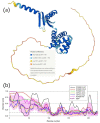I-Shaped Dimers of a Plant Chloroplast FOF1-ATP Synthase in Response to Changes in Ionic Strength
- PMID: 37445905
- PMCID: PMC10341776
- DOI: 10.3390/ijms241310720
I-Shaped Dimers of a Plant Chloroplast FOF1-ATP Synthase in Response to Changes in Ionic Strength
Abstract
F-type ATP synthases play a key role in oxidative and photophosphorylation processes generating adenosine triphosphate (ATP) for most biochemical reactions in living organisms. In contrast to the mitochondrial FOF1-ATP synthases, those of chloroplasts are known to be mostly monomers with approx. 15% fraction of oligomers interacting presumably non-specifically in a thylakoid membrane. To shed light on the nature of this difference we studied interactions of the chloroplast ATP synthases using small-angle X-ray scattering (SAXS) method. Here, we report evidence of I-shaped dimerization of solubilized FOF1-ATP synthases from spinach chloroplasts at different ionic strengths. The structural data were obtained by SAXS and demonstrated dimerization in response to ionic strength. The best model describing SAXS data was two ATP-synthases connected through F1/F1' parts, presumably via their δ-subunits, forming "I" shape dimers. Such I-shaped dimers might possibly connect the neighboring lamellae in thylakoid stacks assuming that the FOF1 monomers comprising such dimers are embedded in parallel opposing stacked thylakoid membrane areas. If this type of dimerization exists in nature, it might be one of the pathways of inhibition of chloroplast FOF1-ATP synthase for preventing ATP hydrolysis in the dark, when ionic strength in plant chloroplasts is rising. Together with a redox switch inserted into a γ-subunit of chloroplast FOF1 and lateral oligomerization, an I-shaped dimerization might comprise a subtle regulatory process of ATP synthesis and stabilize the structure of thylakoid stacks in chloroplasts.
Keywords: FOF1-ATP synthase; chloroplasts; dimers; membrane proteins; small-angle scattering.
Conflict of interest statement
The authors declare no conflict of interest.
Figures





References
-
- Vlasov A.V., Osipov S.D., Bondarev N.A., Uversky V.N., Borshchevskiy V.I., Yanyushin M.F., Manukhov I.V., Rogachev A.V., Vlasova A.D., Ilyinsky N.S., et al. ATP synthase FOF1 structure, function, and structure-based drug design. Cell. Mol. Life Sci. 2022;79:179. doi: 10.1007/s00018-022-04153-0. - DOI - PMC - PubMed
MeSH terms
Substances
Grants and funding
LinkOut - more resources
Full Text Sources

